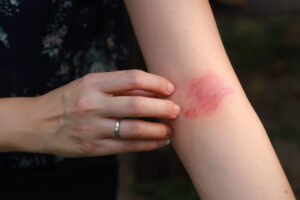Bacterial vs Viral Skin Infections- How Can You Tell Which is Which?

Your skin is your body’s first line of defense against infections, but sometimes it can fail to protect you. When bacteria or viruses invade your skin, they can cause skin infections that can be painful, itchy, and cause a lot of discomfort. But how do you determine if you have a bacterial or viral skin infection? In this blog post, we will discuss the signs and symptoms of both bacterial and viral skin infections, and how you can tell which is which.
Viral Skin Infections
A virus causes viral skin infections, and they can be highly contagious. The hallmark of a viral skin infection is a rash that is often accompanied by fever, swollen glands, and body aches. A few of the most common viral skin infections include chickenpox, shingles, and warts. Chickenpox usually starts with the appearance of small, itchy red bumps that turn into fluid-filled blisters and scabs. Shingles cause a painful, blistering rash that can last for several weeks. Warts are another type of viral skin infection that usually appears as small, hard bumps on the skin.
Bacterial Skin Infections
Bacteria cause bacterial skin infections and can also be highly contagious. Some of the most common bacterial skin infections include impetigo, cellulitis, and folliculitis. Impetigo usually starts as a red sore on the face, but it can quickly spread to other parts of the body. Cellulitis is a more serious bacterial skin infection that affects the deeper layers of the skin and can cause redness, pain, and swelling. Finally, folliculitis is a bacterial infection of the hair follicles that causes small, red bumps on the skin.
How Do You Determine Which Kind of Skin Infection You Have?
The best way to determine whether you are dealing with a bacterial or viral skin infection is to see a dermatologist. Your dermatologist can examine your skin, perform tests, and recommend the appropriate treatment. Sometimes, your dermatologist may need to prescribe antibiotics to treat bacterial skin infections, while antiviral medications can treat viral skin infections.
Book an Appointment with Swinyer Woseth Dermatology for a Diagnosis You Can Trust!
If you need a dermatologist, you can count on Swinyer Woseth Dermatology. Our experienced dermatologists can diagnose and treat a wide range of skin disorders, including bacterial and viral skin infections. We offer a range of services, including acne treatment, mole removal, and skin cancer screenings. Our goal is to help you achieve healthy, beautiful skin that makes you feel confident and attractive. If you need a dermatologist, contact Swinyer Woseth Dermatology. We are here to assist you in getting skin that is healthy and gorgeous, making you look and feel your absolute best.
